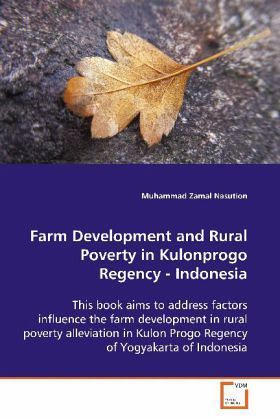
Farm Development and Rural Poverty in Kulonprogo Regency - Indonesia
This book aims to address factors influence the farm development in rural poverty alleviation in Kulon Progo Regency of Yogyakarta of Indonesia.
Versandkostenfrei!
Versandfertig in 6-10 Tagen
37,99 €
inkl. MwSt.

PAYBACK Punkte
19 °P sammeln!
Poverty has always been a concern in Indonesia. More than half of Indonesia''s 235 million people are poor. The district of Kulon Progo is the second lowest district in Yogyakarta province both in economic growth and welfare level, so less developed among four others district. Regression model is developed with classical normal linier regression model to reveal each variable share on rural poverty. Simultaneously, this linear regression model explains 70% of rural poverty caused by all variables. Numbers of farmer positively affects numbers of poor rural inhabitants. Irrigated land has a negat...
Poverty has always been a concern in Indonesia.
More
than half of Indonesia''s 235 million people are
poor. The district of Kulon Progo is the second
lowest district in Yogyakarta province both in
economic growth and welfare level, so less
developed
among four others district. Regression model is
developed with classical normal linier regression
model to reveal each variable share on rural
poverty. Simultaneously, this linear regression
model explains 70% of rural poverty caused by all
variables. Numbers of farmer positively affects
numbers of poor rural inhabitants. Irrigated land
has a negative impact to rural poverty. Numbers of
household member is not significant to influence
poor rural inhabitants. In contrary of common
belief, the significant role of land ownership has
a
positive impact to influence rural poverty, where
the 1% increasing size of land ownership will raise
0.177% poor rural inhabitants. Regression model
results land ownership positively affects rural
poverty.
More
than half of Indonesia''s 235 million people are
poor. The district of Kulon Progo is the second
lowest district in Yogyakarta province both in
economic growth and welfare level, so less
developed
among four others district. Regression model is
developed with classical normal linier regression
model to reveal each variable share on rural
poverty. Simultaneously, this linear regression
model explains 70% of rural poverty caused by all
variables. Numbers of farmer positively affects
numbers of poor rural inhabitants. Irrigated land
has a negative impact to rural poverty. Numbers of
household member is not significant to influence
poor rural inhabitants. In contrary of common
belief, the significant role of land ownership has
a
positive impact to influence rural poverty, where
the 1% increasing size of land ownership will raise
0.177% poor rural inhabitants. Regression model
results land ownership positively affects rural
poverty.












